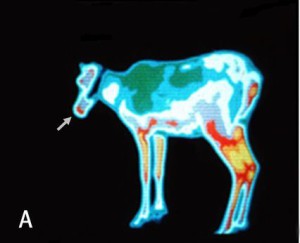Why Rudolph’s nose is red: observational study from the Netherlands
Researchers from the Netherlands and Norway published an observational study in the British Medical Journal (BMJ) explaining the morphology behind Rudolph’s famous red nose. They hypothesized that the extreme redness was caused by “the presence of a highly dense and rich nasal microcirculation”. In other words, Rudolph’s nose has an abundant supply of red blood cells flowing through a vast number of tiny blood vessels. Results of the study show that the hypothesis was proven. After a careful comparison with five human subjects, the researchers determined that while similar, the vascular network in a reindeer’s nose is 25% denser than that in a human.
Also, perhaps even more interestingly, the tiny blood vessels in the reindeer’s nose do not contain red blood cells during diastole (the time between heart beats); with systole (heart beat), an excess of blood is forced through the vessels. The figure below shows the infrared image of a reindeer’s head after a treadmill test. Notice the presence of a red nose.
The reindeer nasal anatomy and physiology observed in this study testifies to the eminent suitability of Rudolph to lead Santa’s sleigh.
Article: Ince, C., van Kuijen, A. M., Milstein, D. M., Yuruk, K., Folkow, L. P., Fokkens, W. J., & Blix, A. S. (2012). Why rudolph’s nose is red: Observational study. BMJ (Clinical Research Ed.), 345, e8311. doi:10.1136/bmj.e8311 [doi]
Have a Merry Christmas and a Happy New Year!
Jill Turner, Librarian Consultant
Graphics:
Rudolph the Rednosed Reindeer: GuitarHero188Rock
Infrared image of reindeer: Blix, As. Arctic Animals. Tapir Academic Press, 2005.


